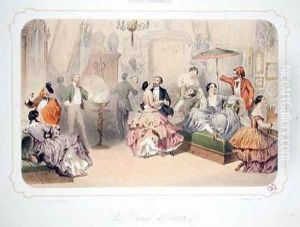Henri de Montaut Paintings
Henri de Montaut, also known as Henri de Montault, was a French illustrator and engraver best known for his work in popular periodicals during the 19th century. Born in 1825, Henri's early years coincide with a period of significant political and social change in France, which would go on to influence much of his artistic output.
Montaut started his career as an illustrator in the 1850s. His work was characterized by its detailed depiction of technological advancements and historical events. During this time, the industrial revolution was in full swing, and there was a great public interest in new inventions and the progress of engineering. Montaut captured this excitement in his illustrations, which often featured trains, ships, and other marvels of the age.
He became particularly well-known for his work published in magazines such as 'L'Illustration', a French weekly illustrated newspaper. Montaut's engravings for 'L'Illustration' covered a wide range of subjects, including the Crimean War and the American Civil War, events that were of intense interest to the European public.
As an engraver, Montaut was responsible for creating images that would be reproduced in various publications. His technique involved engraving onto wood blocks or metal plates, which were then used to print images onto paper. This was a labor-intensive process that required a high degree of skill and precision.
Montaut's work is notable not only for its historical value but also for its stylistic qualities. His engravings are detailed and precise, reflecting a commitment to realism that was typical of the period's illustrative work. He had a knack for capturing the essence of the machines and events he depicted, conveying both their technical details and the excitement they inspired.
Henri de Montaut's contributions to illustration continued up until his death in 1897. While not as widely remembered as some of his contemporaries, his work remains an important part of the visual culture of the 19th century, documenting an era of rapid change and innovation. His illustrations offer a window into the past, showing the marvels of the industrial age through the eyes of a contemporary observer.








